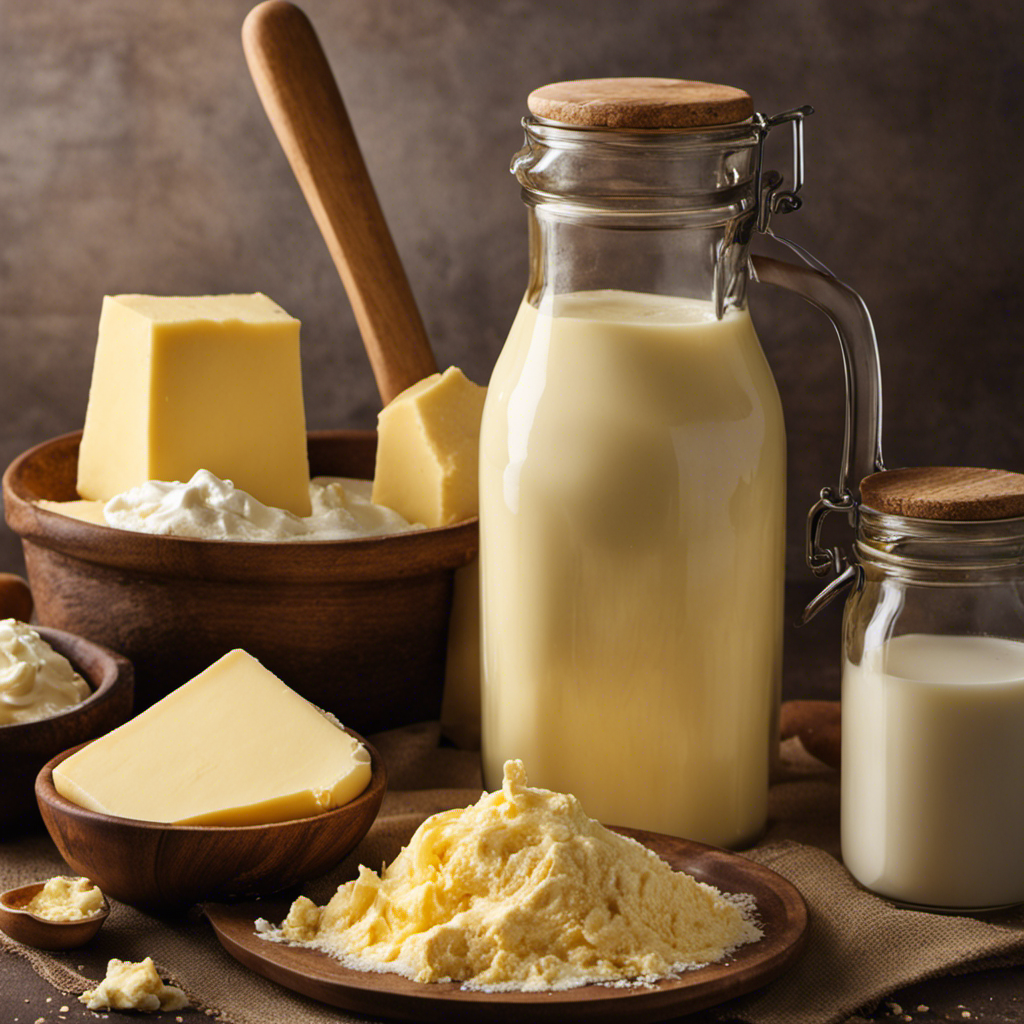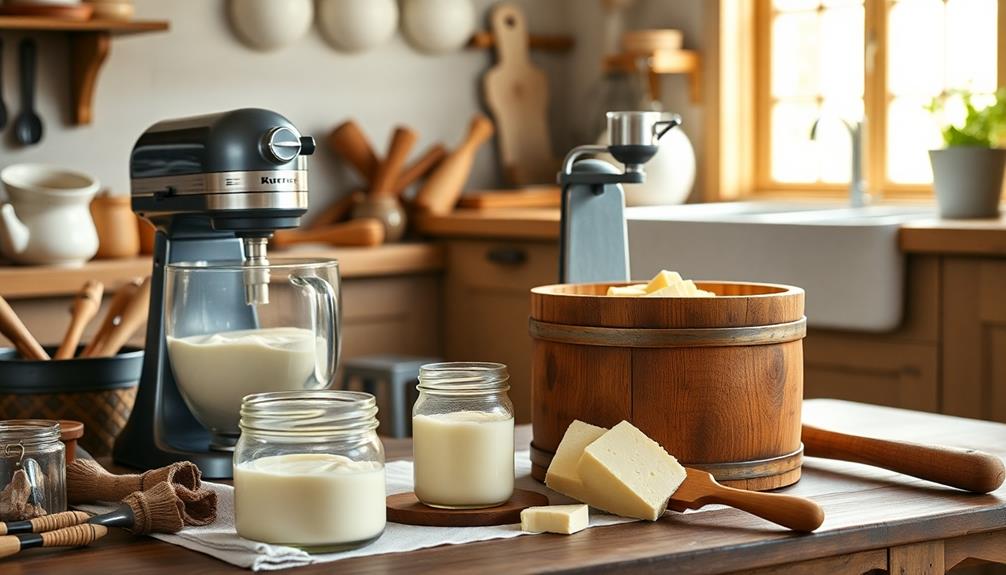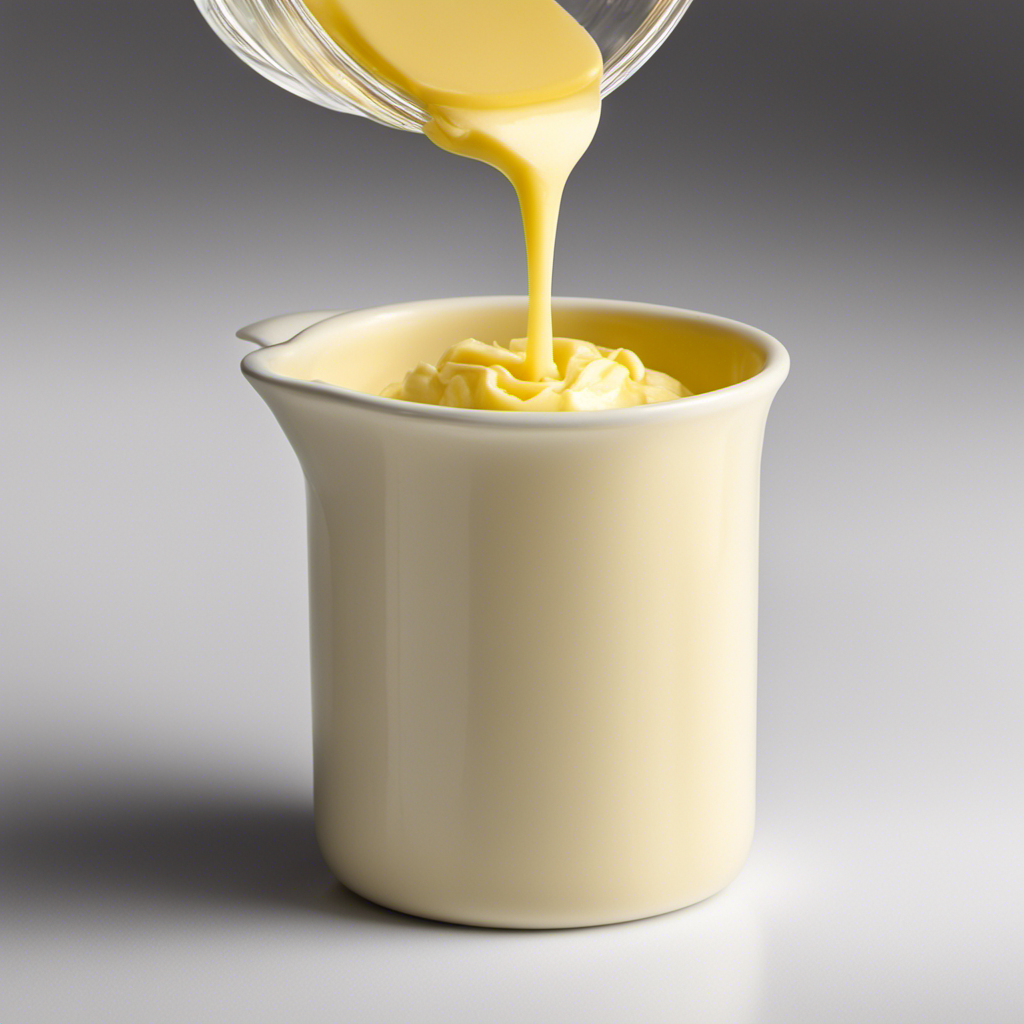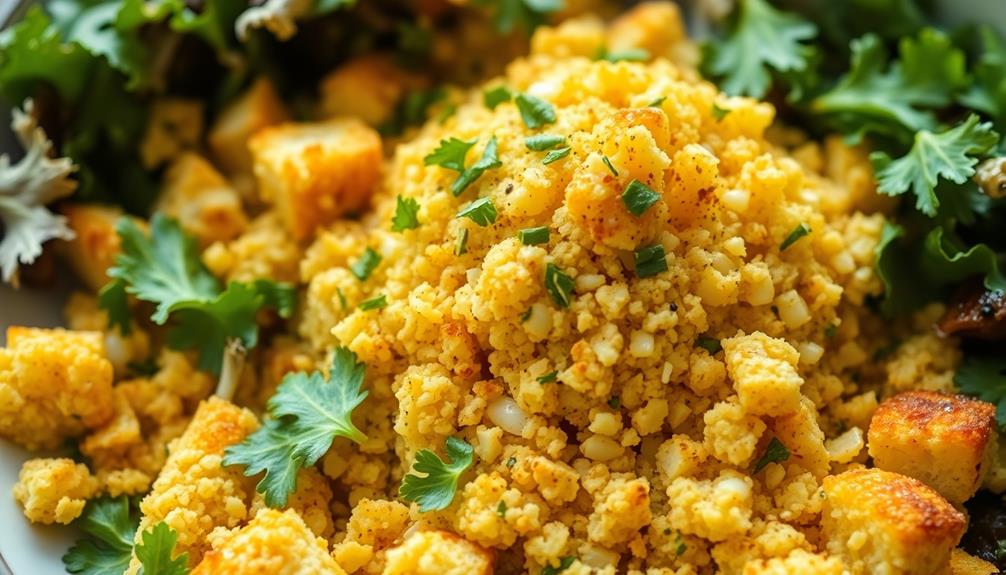I often mention that the pleasure derived from creating your own butter from the ground up is unparalleled. In this piece, I will walk you through each phase of the procedure, allowing you to delight in the process of turning milk into rich, homemade butter.
We’ll start by gathering the necessary ingredients and selecting the right type of milk. From there, we’ll prepare the milk, choose the appropriate equipment, and churn our way to delicious butter.
So, let’s roll up our sleeves and get started!
Key Takeaways
- Choose fresh milk with higher butterfat content for better taste and quality of butter.
- Consider dairy and non-dairy options like almond milk, which is lactose-free, low in calories, and provides additional health benefits.
- Understand the differences between fresh and pasteurized milk, with fresh milk retaining natural enzymes but carrying a higher risk of bacterial contamination.
- Prefer organic milk for perceived health benefits, environmental sustainability, and higher levels of beneficial nutrients compared to conventional milk.
Gathering the Necessary Ingredients
To make butter from milk, you’ll need to gather the necessary ingredients. The first step is choosing fresh milk, preferably from a local dairy or farm. Fresh milk ensures a higher butterfat content, which is crucial for making butter.
Next, you need to consider the milk temperature for butter making. Ideally, the milk should be at room temperature, around 68-72°F (20-22°C). This temperature allows the cream to separate more easily during the churning process. If the milk is too cold, it may take longer to separate, and if it’s too warm, the butter may turn out greasy.
Choosing the Right Type of Milk
When it comes to choosing the right type of milk, there are several key points to consider. These include dairy versus non-dairy options, fresh versus pasteurized milk, and organic versus conventional milk. These factors can greatly impact the taste, nutritional value, and overall quality of the milk you consume.
It is important to understand the differences between these options in order to make an informed decision that aligns with your preferences and dietary needs.
Dairy Vs. Non-Dairy Options
If you’re looking for a dairy-free option, almond milk can be a great alternative to regular milk when making butter. Almond milk is one of the many dairy-free alternatives available in the market today. It is made from ground almonds and water, providing a creamy and nutty flavor.
Almond milk is not only lactose-free but also low in calories and saturated fat, making it a healthier choice for those looking to reduce their dairy intake. It is also a good source of vitamins and minerals, such as vitamin E and calcium.
Incorporating almond milk into your butter-making process can provide the same rich and creamy texture as regular milk, while offering the added health benefits of non-dairy options.
Fresh or Pasteurized Milk
Fresh milk is a popular choice for those who prioritize taste and prefer a more natural product. When it comes to milk, there are two main options: raw and processed.
Raw milk, also known as unpasteurized milk, is milk that has not undergone the process of pasteurization, which involves heating the milk to kill harmful bacteria. While raw milk carries a higher risk of bacterial contamination, it also has several benefits. It retains more of its natural enzymes and beneficial bacteria, which can aid in digestion and boost the immune system. However, it is important to note that raw milk should only be consumed from reputable sources to minimize the risk of foodborne illnesses.
Transitioning to the next section, let’s now explore the difference between organic and conventional milk.
Organic or Conventional Milk?
Organic milk is becoming increasingly popular due to its perceived health benefits and environmental sustainability. Consumers are more conscious about the farming methods used to produce their milk and are willing to pay a premium for organic products. But what exactly is the difference between organic and conventional milk?
Organic farming methods prioritize the use of natural fertilizers, crop rotation, and the absence of synthetic pesticides and antibiotics. This results in milk that is free from potentially harmful residues. On the other hand, conventional farming methods often involve the use of synthetic fertilizers, pesticides, and antibiotics, which can end up in the milk we consume.
When it comes to nutritional differences, studies have found that organic milk contains higher levels of omega-3 fatty acids, vitamin E, and antioxidants compared to conventional milk. Additionally, organic milk has been shown to have lower levels of certain hormones and antibiotics.
In conclusion, choosing organic milk means opting for a more sustainable and potentially more nutritious option. Check out the table below for a detailed comparison of organic and conventional farming methods and the nutritional differences between the two.
| Organic Farming Methods | Conventional Farming Methods | Nutritional Differences |
|---|---|---|
| Natural fertilizers | Synthetic fertilizers | Higher omega-3 fatty acids, vitamin E, and antioxidants |
| Crop rotation | No specific crop rotation | Lower levels of hormones and antibiotics |
| No synthetic pesticides | Use of synthetic pesticides |
Preparing the Milk for Butter Making
When it comes to making butter, the quality of the milk plays a crucial role. It is important to use milk that is fresh and of high quality to ensure a rich and flavorful end product.
Additionally, the process of skimming or separating the cream from the milk is an important step in butter making, as it determines the butterfat content and texture of the final product.
Milk Quality for Butter
To ensure the best quality butter, you’ll want to start with milk that has a high fat content. Milk quality assessment is crucial in determining the suitability of milk for butter making. Here are some key factors to consider:
- Fat content: Milk with higher fat content, such as whole milk or cream, will yield a richer and creamier butter.
- Freshness: Fresh milk is essential for butter making. It should be free from any off-flavors or odors.
- Purity: The milk should be free from any impurities, such as dirt or bacteria, which can negatively affect the quality of the butter.
- Temperature: The milk should be chilled before processing to ensure proper separation of cream from the milk.
Skimming or Separating Cream?
If you’re unsure about skimming or separating cream, it’s important to consider the fat content and the desired texture of your final product.
Skimming cream involves removing the cream that naturally rises to the top of fresh milk. This cream contains a higher fat content, usually around 30%.
Separating cream, on the other hand, involves using a separator to extract the cream from the milk. This method allows for more precise control over the fat content, as you can choose to separate just the cream or a specific percentage of it. The fat content in separated cream can vary depending on your preference, ranging from 10% to 50%.
Ultimately, the choice between skimming or separating cream depends on the fat content you desire for your butter and the level of control you want over the process.
Selecting the Appropriate Equipment
The first step in making butter from milk is choosing the right equipment. When it comes to equipment maintenance, it’s important to keep your tools clean and in good working condition. Here are some tips for troubleshooting common equipment issues:
- Check the motor: Ensure that the motor is functioning properly and that there are no loose connections or damaged parts.
- Inspect the blades: Make sure the blades are sharp and securely attached to the churn. Dull blades or loose attachments can affect the churning process.
- Monitor temperature: Maintain an optimal temperature for churning. Too high or too low temperatures can result in improper butter formation.
- Clean after each use: Thoroughly clean and sanitize the equipment after each use to prevent bacterial growth and maintain hygiene.
Churning the Milk Into Butter
After churning, it’s important to strain the mixture to separate the liquid from the solids. This step is crucial in the butter making process as it ensures a smooth and creamy final product.
To strain the mixture, a fine mesh sieve or a cheesecloth can be used. These tools effectively catch the solid butter while allowing the liquid, known as buttermilk, to pass through.
By straining the mixture, any leftover bits of milk or curds that may have formed during the churning process are removed. This results in a purer butter with a longer shelf life.
Additionally, straining helps to achieve the desired texture and consistency of the butter. Mastering the churning techniques and subsequent straining is essential for creating high-quality homemade butter.
Separating the Butter From Buttermilk
To separate the butter from the buttermilk, strain the mixture using a fine mesh sieve or a cheesecloth. This separating technique is essential in the process of making butter from milk.
Once you have strained the mixture, you will be left with two distinct components: the creamy butter and the tangy buttermilk.
Here are some interesting uses for buttermilk:
- Baking: Buttermilk adds moisture and tanginess to baked goods like pancakes, biscuits, and cakes.
- Marinades: The acidic nature of buttermilk makes it a great tenderizer for meats. Marinating chicken or pork in buttermilk helps to break down the proteins, resulting in tender and flavorful dishes.
- Salad dressings: Buttermilk can be combined with herbs, vinegar, and spices to create creamy and tangy dressings for salads.
- Smoothies: Adding buttermilk to your smoothies can give them a unique tang and creamy texture.
Washing and Kneading the Butter
Washing and kneading the butter are crucial steps in the process of making butter from milk.
The importance of washing the butter lies in removing any remaining buttermilk, which can cause the butter to spoil quickly.
To wash the butter, it is necessary to knead it under cold water until the water runs clear, ensuring a clean and long-lasting product.
Importance of Washing
Now that you know why washing is important, let’s move on to the next step in making butter from milk.
Washing the butter serves two purposes: removing any remaining buttermilk and improving its texture. Here are the benefits of washing:
- Removes excess buttermilk, preventing spoilage and extending the shelf life of the butter.
- Enhances the flavor by eliminating any residual tanginess from the buttermilk.
- Improves the consistency and spreadability of the butter, making it easier to use.
- Removes any impurities or unwanted substances that may have been present during the churning process.
Temperature control is crucial during the washing process. It is recommended to use cold water to ensure the butter remains firm and doesn’t melt.
Additionally, homemade butter offers several advantages, such as knowing the quality of ingredients used, controlling the level of salt or flavorings, and the satisfaction of enjoying a fresh and natural product.
Kneading Technique Explained
During the kneading process, it’s important to use a gentle touch to avoid overworking the dough. Kneading is a crucial step in butter-making as it helps develop the butter’s texture and consistency.
To achieve the desired result, start by gently folding the dough in half, then pressing it away from you with the heel of your hand. Rotate the dough a quarter turn and repeat the process. This technique helps distribute the fat evenly, ensuring a smooth and creamy butter.
Avoid excessive kneading as it can lead to a tough and dense texture. Once the dough has reached the desired consistency, it’s time to move on to the next step: adding salt (optional).
Adding Salt (Optional
If you’d like to enhance the flavor of your butter, you can add salt to the mixture. However, if you’re looking for salt alternatives or want to reduce your sodium intake, there are a few options you can consider.
Here are some alternatives to traditional table salt:
- Sea salt: A natural alternative that contains trace minerals and can add depth to the flavor of your butter.
- Himalayan pink salt: Known for its pink hue and high mineral content, it can provide a unique taste to your butter.
- Herb-infused salt: By combining herbs like rosemary, thyme, or garlic with salt, you can create a flavorful blend for your butter.
- Citrus zest: Adding grated lemon or orange zest to your butter can provide a refreshing and tangy twist.
When it comes to health benefits, using salt alternatives can be beneficial. Sea salt and Himalayan pink salt contain minerals that can support hydration and electrolyte balance. Herb-infused salt adds extra flavor without the need for excessive sodium, and citrus zest provides a dose of vitamin C and antioxidants.
Storing and Preserving Homemade Butter
To ensure your homemade butter stays fresh and flavorful for longer periods of time, you should store it in an airtight container in the refrigerator.
This is one of the most effective preserving methods for extending the shelf life of homemade butter. By keeping it in an airtight container, you are preventing air from getting in and causing oxidation, which can lead to rancidity.
The refrigerator also helps to maintain a cool temperature, further inhibiting the growth of bacteria and other microorganisms that can spoil the butter. It is important to note that butter can absorb odors from other foods, so storing it in an airtight container will also help to prevent this.
Using Leftover Buttermilk
One way to utilize leftover buttermilk is by making fluffy pancakes or biscuits. Buttermilk is a versatile ingredient that adds a tangy flavor and tender texture to baked goods.
Here are some ways to make the most of your leftover buttermilk:
- Use it as a marinade for chicken or pork to tenderize and add flavor.
- Make a creamy salad dressing by combining buttermilk with herbs and spices.
- Use it as a substitute for milk in your favorite cake or muffin recipes for a moist and rich texture.
- Whip up a refreshing buttermilk smoothie by blending it with fruits and a touch of honey.
Not only does using buttermilk in baking enhance the taste and texture of your creations, but it also offers health benefits. Buttermilk is low in fat and calories, while being rich in calcium, protein, and probiotics.
Troubleshooting Common Butter Making Issues
Having trouble with your butter-making process? Don’t worry, I’ve got you covered! As a seasoned butter maker, I have encountered my fair share of common issues in butter making. To help you troubleshoot, I have compiled a handy table below highlighting some of the most common problems and their solutions.
| Issue | Possible Causes | Solutions |
|---|---|---|
| Butter not forming | Insufficient fat content in cream | Use cream with higher fat content |
| Butter too soft or runny | Over-churning or inadequate chilling | Churn for shorter time or chill longer |
| Butter has off-flavors or odors | Contaminated cream or improper storage | Use fresh cream and store at proper temperatures |
Exploring Different Variations and Flavors
If you’re feeling adventurous, you can experiment with various ingredients and flavors to create unique variations of your homemade butter. Here are four exciting ways to explore different variations and experiment with flavors:
- Infuse your butter with herbs and spices like garlic, rosemary, or chili flakes to add a savory kick.
- Incorporate sweet flavors by mixing in honey, maple syrup, or vanilla extract for a delicious spread on toast or pancakes.
- For a tangy twist, try adding lemon zest or squeeze in some fresh citrus juice to brighten up your butter.
- Get creative with savory-sweet combinations by mixing in dried fruits, nuts, or even bacon bits.
Frequently Asked Questions
How Long Does It Take to Make Butter From Milk?
It takes about 20-30 minutes to make butter from milk. The time may vary depending on factors like temperature and agitation. Homemade butter tends to have a richer flavor and creamier consistency compared to store-bought butter.
Can I Use Non-Dairy Milk Alternatives to Make Butter?
Yes, non-dairy milk alternatives can be used to make butter. However, the butter making process may differ from traditional methods due to the absence of milk fat.
What Is the Difference Between Salted and Unsalted Butter?
Salted and unsalted butter differ in their salt content. Salted butter is typically used for savory dishes, while unsalted butter is preferred for baking. The nutritional differences between the two are minimal, but salted butter adds a savory flavor profile to dishes.
Can I Use a Blender or Food Processor Instead of a Churn to Make Butter?
Certainly! Using a blender or food processor as an alternative method for making butter is possible. However, it may not be as effective as using a churn. The churning process helps separate the butterfat from the buttermilk more efficiently.
How Long Can Homemade Butter Be Stored in the Refrigerator?
Homemade butter can be stored in the refrigerator for about 2-3 weeks. To maximize shelf life, it’s important to store it in an airtight container and keep it away from strong odors.
Conclusion
In conclusion, making butter from milk is a simple and rewarding process. By following the steps outlined in this article, you can create your own delicious homemade butter.
Just like how churning milk transforms it into a creamy and spreadable delight, we too have the power to transform our own lives through our choices and actions.
Just as the butter becomes a product of our effort and intention, so too can we shape our own destinies.
So go forth, gather your ingredients, and churn your way to a better future.









